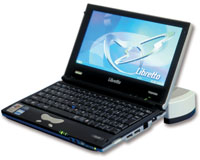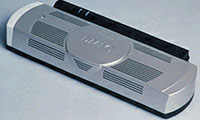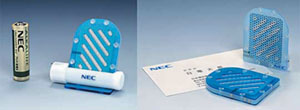One for the Road
Back to Contents of Issue: July 2003
|
|
|
|
by Richard Donovan |
|
 FOR ALL WE HEAR of the rapid pace of technological development, many users in the real world consider the following truths to be self-evident: Your notebook computer never has enough juice to finish a job on the go, and commercial fuel cells are a pipe dream decades away from realization. FOR ALL WE HEAR of the rapid pace of technological development, many users in the real world consider the following truths to be self-evident: Your notebook computer never has enough juice to finish a job on the go, and commercial fuel cells are a pipe dream decades away from realization.
Well, in 2004 (as J@pan Inc reported in its May issue) companies such as NEC and Toshiba are set to challenge both these truisms with a single sleek package -- a fuel-cell battery pack that will power your portable PC for just about as long as you can type. Late in the first quarter of this year, both computer giants demonstrated working prototypes of micro fuel cells which they will commercialize next year, beginning with corporate clients.
Several breakthroughs have led to this synergy of diverse technologies that may soon revolutionize portable electronics. A fuel cell is a type of battery that produces electric current when a catalyst, such as platinum, induces hydrogen (the eponymous "fuel") to react with oxygen. The only byproducts in a hydrogen fuel cell are water and heat, making it theoretically eco-friendly -- as long as the hydrogen itself is derived from a clean source.
At minimum, fuel cells offer While fuel cells have been around for over a century and a half -- beginning with William Grove's so-called "gas battery" in 1838 -- they have mostly relied on pure hydrogen as a fuel source, often requiring high temperatures and pressures to react efficiently with ambient oxygen and produce electricity. However, recent breakthroughs in Direct Fuel Cell (DFC) technology have allowed manufacturers to work directly with hydrogen-rich fuels such as methanol, ethanol and natural gas, eliminating expensive, bulky reformers and extreme operating conditions, though admittedly emitting small amounts of carbon dioxide in the process.
However, DFC technology on its own was not enough to permit the extreme miniaturization necessary to allow fuel cells to complement notebooks. A number of companies are independently finding proprietary solutions to this.
So what can we expect from the merry little cells? At the bare minimum, two to three times the life of lithium-ion batteries. And that's just the start. While conventional notebook batteries must be recharged for hours, fuel cartridges can be "hot-swapped" in a matter of seconds, allowing an uninterrupted power supply limited only by the number of cartridges or refills available. The smallest cartridges will be about matchbox size and weigh a fraction of the weight of a rechargeable battery.
Still, a number of hurdles to commercialization remain for portable fuel cell manufacturers. The biggest, particularly in the current international security climate, is getting permission from airlines to carry potentially flammable substances aboard their craft. A number of the makers have anticipated this and are banding together to produce a standardized cartridge that will be leak-proof and conform to international safety standards. The US Department of Transportation has already approved one prototype notebook fuel cell for use on planes, but this contains a relatively low concentration of methanol. It remains to be seen how the aviation world will receive full-strength cartridges such as Toshiba's.
Unfortunately, it seems unlikely that there will be room for user-refillable cartridges in the market partly because manufacturers will be reluctant to encourage consumers to squirt flammable liquids around, but at the same time they'll be more than willing to charge the predominantly affluent users a highly inflated price for pre-packaged methanol. It would be ironic if a potentially environmentally friendly product were to add to waste-disposal problems.
Another headache is that while fuel cartridges can be made relatively tiny, the fuel-cell processing units themselves are still nowhere near small enough to fit inside notebook computers. Toshiba's unit, for example, attaches to the conventional battery terminals of a notebook as something like a docking station, with space to slot in the detachable fuel cartridge and grills to allow air in and heat out. A few may balk at the retro-look ungainliness, but many business itinerants will still appreciate the level of convenience.
The ultimate goal will be to "imbed" notebooks with fuel cells that are integral to the body of the computer and share its vents, with the only removable part being a tiny exchangeable cartridge. When the cells reach this level of diminution and have proven their durability on the go, they will be ready for other smaller, rougher-handled devices such as mobile phones and PDAs. Given the dramatic miniaturization occurring in the fuel-cell industry, this cannot be far over the horizon. @ |
|
Note: The function "email this page" is currently not supported for this page.


 In NEC's case, the "pipe" dream has literally become a reality, because their fuel cell utilizes carbon nanotubes -- carbon arranged at the atomic level into inconceivably small pipe-shaped structures -- which act like room-temperature superconductors and enable far more efficient ion exchange, and hence a more compact fuel-cell unit. This is an exciting result of NEC's decade-long investment in nanotubes: They can proudly claim that their research fellow Sumio Iijima discovered them in 1991 (see page 18 for an interview with Ijima). While nanotubes will one day become indispensable in next-generation molecular-level electronics, NEC has already found a practical use for them in its micro fuel cells. Here they exist in an incarnation called "nanohorns": One end of these minute carbon constructs is splayed out like a cornet, making it ideal for absorbing reactant gases (see
In NEC's case, the "pipe" dream has literally become a reality, because their fuel cell utilizes carbon nanotubes -- carbon arranged at the atomic level into inconceivably small pipe-shaped structures -- which act like room-temperature superconductors and enable far more efficient ion exchange, and hence a more compact fuel-cell unit. This is an exciting result of NEC's decade-long investment in nanotubes: They can proudly claim that their research fellow Sumio Iijima discovered them in 1991 (see page 18 for an interview with Ijima). While nanotubes will one day become indispensable in next-generation molecular-level electronics, NEC has already found a practical use for them in its micro fuel cells. Here they exist in an incarnation called "nanohorns": One end of these minute carbon constructs is splayed out like a cornet, making it ideal for absorbing reactant gases (see  Toshiba, on the other hand, has focused on reducing the size of the fuel reservoir to miniaturize their unit. Fuel cells just don't have the stomach for neat methanol: Above a certain concentration, it actually reduces the efficiency of the electrochemical conversion process (an undesirable effect called "methanol crossover" -- perhaps the tech equivalent of a hangover). To obtain the optimum dilution of 3 to 6 percent methanol to water, explains Toshiba publicist Midori Suzuki, the unit cleverly capitalizes on the fact that fuel cells' main waste product is pure water. It feeds the water back into the fuel line; this self-dilution means the fuel cartridge can contain near-pure methanol in a handy 50ml or 100ml size. "Toshiba is first in the world to develop a fuel cell that can be directly attached to a portable PC without any cable," Suzuki adds. "Other companies, including NEC, need a cable to link their cells to the computer."
Toshiba, on the other hand, has focused on reducing the size of the fuel reservoir to miniaturize their unit. Fuel cells just don't have the stomach for neat methanol: Above a certain concentration, it actually reduces the efficiency of the electrochemical conversion process (an undesirable effect called "methanol crossover" -- perhaps the tech equivalent of a hangover). To obtain the optimum dilution of 3 to 6 percent methanol to water, explains Toshiba publicist Midori Suzuki, the unit cleverly capitalizes on the fact that fuel cells' main waste product is pure water. It feeds the water back into the fuel line; this self-dilution means the fuel cartridge can contain near-pure methanol in a handy 50ml or 100ml size. "Toshiba is first in the world to develop a fuel cell that can be directly attached to a portable PC without any cable," Suzuki adds. "Other companies, including NEC, need a cable to link their cells to the computer."




